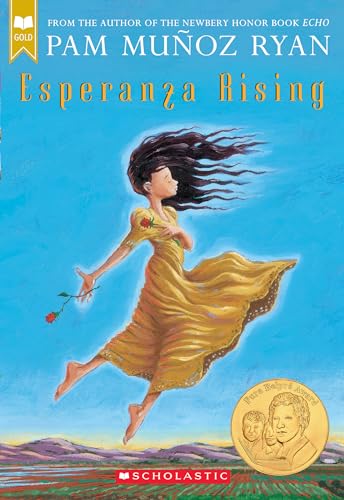Get ready folks, because we’re veering into the world of “Esperanza Rising” in this review. This book does a superb job at whisking you away into the turbulent 1930s, where we follow young Esperanza and her unexpected journey of adaptation. Whether it’s the portrayal of cultural heritage or classic coming-of-age themes, the book’s vibrancy can’t be missed. But, like my first attempt at making a soufflé (spoiler: it flopped), nothing is without its faults. So buckle up as we explore the highs and lows of this compelling story!
In a nutshell
Esperanza Rising by Pam Muñoz Ryan is an inspiring historical fiction novel. It captures the heart and soul of a young girl named Esperanza. She discovers resilience and hope amid adversity. Set in the 1930s, the book touches on themes of cultural identity and personal growth. Esperanza transitions from a life of privilege in Mexico to a challenging existence in a California labor camp. The story expertly navigates issues such as social class and the immigrant experience. It’s an uplifting tale that showcases the strength of the human spirit.
Esperanza Rising: Unforgettable Character Development and Growth
Esperanza Ortega stands at the heart of “Esperanza Rising,” a book that takes character development to another level. As I read about Esperanza’s journey, I remembered my teenage years when I was convinced my video game high-scores were of critical importance. Like Esperanza, I had no clue about the impending reality check called adulthood!
At the beginning, Esperanza appears as a spoiled, wealthy child who believes life’s setbacks are for other people, not her. This was my mindset too, until I learned life isn’t all about nachos and marathon Netflix sessions. When her world turns upside down, and she leaves everything she knew behind, Esperanza begins to change.
Her character grows through overcoming challenges, embracing vulnerability, and ultimately finding her strength. Her transition from a life of privilege to one of struggle and sacrifice shows an inspiring journey from innocence to wisdom. It’s like she went from riding a gold-plated bicycle downhill to pedaling a rusty old three-wheeler uphill – resilience despite the odds.
However, I found some of her changes a bit quick for my liking. One moment she’s crying over roses; the next, she’s picking crops without a tear. It reminded me of the time I decided to suddenly become a gym-goer for a week. My biceps thought otherwise!
Esperanza’s growth is genuine, but it sometimes feels rushed. Despite this, I found myself rooting for her, clumsy transformations and all.
From this character development stems the book’s central themes of resilience and change, which I’ll unravel next, like a surprise birthday cake hidden under the salad at a party.
Themes of Resilience and Change in Esperanza Rising
In Esperanza Rising, Pam Muñoz Ryan weaves a tale of resilience and change that reminds me of trying to learn to ride a unicycle—wobbly at first, but eventually steady. Esperanza Ortega, the protagonist, starts off her life in a lush, privileged environment in Mexico, living like she’s the star in a fancy novela. But like a plot twist worthy of the best soap operas, her world turns upside down when her father dies and she and her mother are forced to flee to California.
The theme of resilience is unavoidable, like that time I tried to make a souffle but it fell flat. Esperanza takes on the new challenges of her life with determination, learning that true strength comes from picking yourself up after every fall (or failed souffle). The spark of change is ignited within Esperanza as she adapts to new circumstances, going from silky dresses to laborer’s overalls faster than a blink. She learns the value of hard work, family, and hope—throwing away her old life like that strange sweater your aunt knitted for you one Christmas.
Ryan crafts scenes that vividly depict Esperanza’s internal and external struggles, reminding us that change can be tough, but it also opens doors to new possibilities. The book captures the essence of growing up, disappointed expectations, and unexpected joy.
In the next section, we’ll weave through the historical and cultural context like a needle through a rich tapestry—stay tuned for that adventure!
Historical and Cultural Context of Esperanza Rising
“Esperanza Rising” is set in the 1930s, a period that wasn’t exactly a skip-in-the-park moment in history. This time highlighted the Great Depression’s economic hardships, which felt like the world had collectively misplaced its wallet. The novel captures how farmworkers, like Esperanza’s family, had to pack up their sombreros and move to California for jobs, hoping for a less spicy life.
The Dust Bowl and the Mexican Repatriation also loom large over the story. There was less soil sticking to farmhands than political tension, yet these factors pushed many Mexican families like Esperanza’s into the U.S., where they found not quite the warm welcome mat they expected. In the book, Esperanza shifts from a life of tamales and luxury to the world of apricots and hard knocks.
Culturally, the book is a burrito filled with rich Mexican traditions. Esperanza clung to her past with memories of fiestas, music that could make maracas dance on their own, and familial bonds stronger than a cup of Mexican hot chocolate. However, adapting to a new culture brought about some epic culture shocks, like discovering that not everyone has a personal servant to peel their grapes!
This historical and cultural context in ‘Esperanza Rising’ adds layers to the story, making it as rich as a tres leches cake. Understanding these complexities helps readers appreciate Esperanza’s journey and struggle.
Next, let’s tango into the world of ‘Esperanza Rising’s’ writing style and language, where words dance like salsa on a summer afternoon.
Writing Style and Language in Esperanza Rising
Esperanza Rising, a book that holds a special place on my shelf, uses simple yet evocative language to draw readers into the world of Esperanza Ortega. The author, Pam Muñoz Ryan, masterfully crafts vivid imagery that transports you from the luxurious life in Aguascalientes, Mexico, to the labor camps in California. With every sentence, I felt like I was right there with Esperanza, experiencing her highs and lows.
The language in this book is straightforward but powerful, much like a recipe passed down through generations—clear, meaningful, and full of heart. Muñoz Ryan doesn’t use fancy words, but that’s what makes the story shine. Her storytelling feels honest and accessible, like a conversation with an old friend who knows how to get straight to the point. The Spanish words scattered throughout add authenticity and flair, making it resonate with anyone familiar with—or curious about—Mexican culture. It’s like getting an extra spicy kick in your salsa when you least expect it!
However, sometimes the simplicity might leave you craving a bit more depth in certain scenes. While it makes the book approachable for younger audiences, older readers might find themselves wanting a bit more complexity. But hey, not every story needs to be a tangled mess of metaphors and sophisticated prose.
Overall, the writing style in Esperanza Rising earns a thumbs up from me. It’s engaging, heartfelt, and, most importantly, relatable. This book reminds us that sometimes the simplest words can leave the strongest impact. So yes, I’d recommend giving Esperanza Rising a read. It’s like a warm hug on a chilly day—comforting and worth every moment.
Conclusion
In wrapping up, “Esperanza Rising” offers a poignant tale of resilience and personal growth. Esperanza’s journey from wealth to adversity teaches readers about strength and adaptation, much like my attempts at learning to cook without burning down the kitchen! While the writing style is simple and engaging, it may miss deeper nuances for some. The cultural and historical context enriches the narrative, making it an insightful read. Consider this book if you’re looking for an inspiring story rooted in history with relatable characters. This concludes my review, and hopefully, it helps you decide if “Esperanza Rising” is the right book for you!


